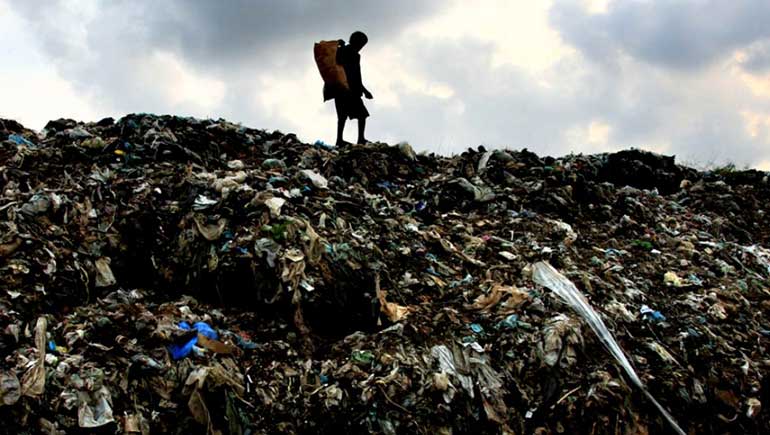Monday Jan 05, 2026
Monday Jan 05, 2026
Wednesday, 27 July 2016 00:02 - - {{hitsCtrl.values.hits}}

Shifting waste from one place to another is no solution; nor is burning it in the backyard. The moment waste is understood as resource, a multitude of solutions are already available to develop a waste free Sri Lanka
The common understanding of “waste” is equivalent with garbage and thus with “an unusable or unwanted substance or material”. Waste, in this case, is perceived with a negative underlying character and regarded as something no one would consider valuable; it is considered as a problem and an unwanted side-effect of our fast, wasteful consumerism and disturbing factor when disposed in public.
 Essentially, each and every product is based on a number of resources which were extracted somewhere around the world and often assembled somewhere else and finally delivered into our shops. Where with many basic food products it is still easy to see what they contain and where they come from, it is nearly impossible to find out ingredients and production processes of more complex products such as for example electronic items or cosmetics.
Essentially, each and every product is based on a number of resources which were extracted somewhere around the world and often assembled somewhere else and finally delivered into our shops. Where with many basic food products it is still easy to see what they contain and where they come from, it is nearly impossible to find out ingredients and production processes of more complex products such as for example electronic items or cosmetics.
After using an item for some time, we feel we do not need it anymore, therefore we dispose it into our bins which are emptied into garbage collection trucks which bring our waste into recycling centres in the best case or into landfills in the worst case; and through this process, items are becoming “waste”. However, even if the form of the product is changed, it still contains at least part of the original resources which have been used to produce it. It is still a sum of resources which are simply considered not useful anymore.
Besides garbage, “waste” also means “anything unused, unproductive or not properly utilised” and “failed to take advantage of or used for profit”. What if waste is a resource by itself? What if a complete circular economy is possible and even a feasible concept?
This is easy to understand in the case of systems which encourage repairing and reusing of items. Besides the benefit that the product is not disposed and can be used again, a number of professions arise around these activities and there is some money to be made – by those who offer repair services and by those who do not need to buy new products.
Repairing is not a new concept, however it is still limited to certain products such as electronics, cars, shoes, handbags and similar items. For a large amount of products there is no service centre, no place to bring it to. Also, often consumers need to pay more for repairing a broken item than buying a new one, thus they chose disposal instead of repair. A diverse system where any item can be repaired will not only create new jobs but also save money and reduce resource extraction as well as garbage.
Furthermore, reusing, donating and sharing are other possibility to make use of items instead of disposing them. In Sri Lanka we have a great culture of helping each other were many in the society who have more, give to those who have less. Concepts such as reusing, sharing and exchanging items can create another dimension where new consumption as well as waste creation are prevented.
In addition, making use of items which can be remodelled to new items, “upcycled”, is another area where materials which are considered not useful anymore, can be developed into completely new items. This thought is also nothing new. For years communities have reused or upcycled items simply because they could not afford to constantly buy new items.
Given the lack of choice of products, communities become innovative and use the older products in new ways. Only the oversupply of new, cheap products makes it easier for consumers to buy those instead of thinking of creative ways of reusing their old items. Recently this concept became more of a trend rather than an expression of lack of choice.
Finally, recycling of various materials has proven successful over the years supplying companies with the necessary raw materials and reducing land fill.
Acknowledging these efforts, a comprehensive circular economy approach tries to fulfil the paradigm of zero-waste creation integrating the above mentioned viewpoint that there is no such thing as “waste”. Every extracted resource which is used to develop a product, can be used and consumed, and when finally losing its initial purpose, it can be reused again in another context. By creating a circulation of resources, no material will go to waste, everything is considered a resource of something else.
Around Colombo and Gampaha region, enormous amounts of garbage have been collected over the past years. Dumping grounds such as the Meethotamulla dump site have been said to be unusable due to their height, odour and various environmental hazards. Current solutions are transferring waste into other landfills as for example in Puttalam – shifting the waste will only shift the problem but not solve it.
Sri Lanka has announced other initiatives which seem promising and more sustainable such as the campaign of the CMC on a new solid waste collection and recycling process educating the public to segregate waste, linked to a collection system and only disposing organic waste into landfill. Such activities are crucial if Sri Lanka wants to progress towards the SDGs.
Also, waste to energy projects have been receiving high priority. At present it is estimated that Colombo produces 700 tons of garbage per day. In this regard, the Sustainable Energy Authority in collaboration with the CMC have implemented the first pilot project at Jathikapola in Narahenpita. This project is deemed to generate 26,280 kWh of electricity per annum.
Additional bottom up initiatives intend to create communities and systems where sharing, exchanging and reusing of items are practiced. These activities not only facilitate a mind-set shift but also influence a change in consumer behaviour.
Solving the “waste challenge”
To solve the “waste challenge” in Sri Lanka, the first step which seems necessary is the mindset change towards a different understanding of what waste is and how it can be used as resource successfully. The stigma of waste being useless and a disturbance has to vanish to enable a sustainable circular economy system.
Globally business, research and political and civil society actors have taken on this concept and perceive it as the future solution for the world’s waste problem – to an extent where the UK Guardian newspaper recently announced that by including concepts such as renewable energy, energy efficiency and material efficiency, the “circular economy could bring a 70% cut in carbon emissions by 2030” and “caring for items through repair, maintenance, upgrading and remanufacturing is far more labour intensive than mining and manufacturing… the number of additional jobs would likely exceed 100,000”.
Entrepreneurs and researchers worldwide are now searching for innovative solutions which help creating this circular economy and lead to zero-waste societies. Besides initiatives to reduce consumption, resource extraction and packaging all together, there are different attempts of using waste as fertiliser and construction material, source to create energy and consumer goods (clothing, jewellery, house items, etc.). Sweden is on top of the list of countries which lead the race to zero-waste by setting up comprehensive waste management systems.
Without diminishing the challenge Sri Lanka has related to its garbage and waste situation, the country is still considerable small to be able to manage the situation well and in a sustainable manner. It has the potential to become zero-waste by developing a comprehensive system including reduced resource extraction (starting with a ban on single use plastic bags for example), upcycling and recycling systems and a movement of reusing and repairing of items.
Shifting waste from one place to another is no solution; nor is burning it in the backyard. The moment waste is understood as resource, a multitude of solutions are already available to develop a waste free Sri Lanka.